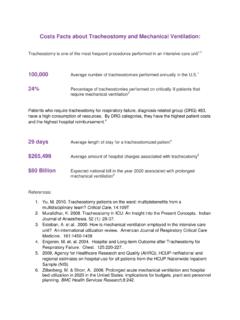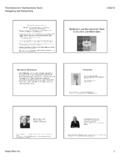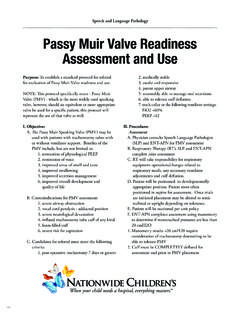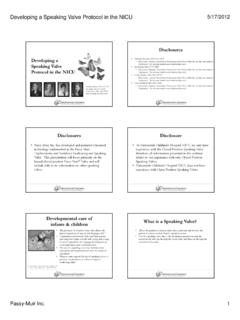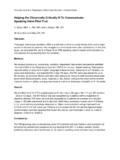Transcription of Speaking Valve Diaphragm Pacing: 10/23/13 …
1 The Speaking Valve and Diaphragm pacing : Changing Lives10/23/13 Passy Muir Wills MA, BA, CRT NPSM adonna Rehabilitation Hospital, Lincoln, NE1 The Speaking Valve and Diaphragm pacing : Changing LivesRebecca Wills MA, BA, CRT NPSM adonna Rehabilitation HospitalLincoln, NEObjectives Describe the physiological impact of respiratory insufficiency in persons with high spinal cord injuries, amyotrophic lateral sclerosis (ALS) and chronic central hypoventilation syndrome (CCHS) Discuss the application of Diaphragm pacing as an alternative or adjunctive therapy to positive pressure ventilation Summarize the role of the Passy Muir Valve in optimizing outcomes for tracheostomy patients with a Diaphragm pacing do these 3 people have in common?
2 ? Mollee, an 18 year old high school senior takes dance classes and loves to play softball Kelli, a 42 year old veterinary assistant from Emporia, Kansas Trent, a 40 year old husband and father of 2 young girlsThey all have respiratory they all have a Diaphragm do we breathe? Volitionally (day time) breathingis controlled by brain s respiratory control center. Night breathing is regulated by CO2 levels measured in the brain. Signals go down the nerves in the neck to the chest and down to the Diaphragm .
3 Phrenic nerve branches out into the muscles of the Diaphragm , causing the diaphragmmuscles to do we breathe? The Diaphragm contracts creatingnegative pressure in the chest cavity. To equalize the pressure, air rushes into the lungs. When the Diaphragm relaxes, the elasticity of the lungs and chest wall pushes the air out of the lungsThe Speaking Valve and Diaphragm pacing : Changing Lives10/23/13 Passy Muir Wills MA, BA, CRT NPSM adonna Rehabilitation Hospital, Lincoln, NE2 What causes respiratory insufficiency?
4 Acute injury or trauma an injury to the chest/ribs an injury to the lungs: inhaling harmful fumes or smoke Drug or alcohol overdose affects the area of the brain that controls breathing Problemswiththespine Problems with the spine scoliosis Lung diseases and conditions COPD, pneumonia ARDS (acute respiratory distress syndrome) pulmonary embolism, cystic fibrosis What causes respiratory insufficiency?Conditions that affect the nerves and muscles that control breathing spinalcordinjuries(SCI) spinal cord injuries (SCI) amyotrophic lateral sclerosis (ALS)National Heart Lung andBlood Institute (NHLBI)SCI: what are the facts?
5 National Spinal Cord Injury Statistical Center (NSCISC) Approximately 12,000new spinal cord injuries (SCI) each year in the United States. In 2008 there was an estimated 259,000 persons in the living,pgwith a SCI. Nearly half of the people with SCI exhibit tetraplegia Approximately 40% of all persons with C1 C4 SCI are vent dependent .Impact of a high cervical injury Bathing, dressing, grooming Meal preparation, eating Bowel care, bladder care Turning in bed Transfers Skin inspection Pressure relief, ROM Medications what does this mean to Trent?
6 August, 2012 surgery to remove a mass on his spine: C3 C4 Paralyzed, able only to turn his head and shrug his shoulders Total dependence on mechanical ventilator to stay alive Complete dependence for all of his cares Unable to eat or speakWhat is ALS? Amyotrophic lateral sclerosis (ALS) is also known as Lou Gehrig s Disease or motor neuron disease. als It is a relentlessly progressive and fatal disease characterized by motor neuron degeneration affecting nerve cells in the brain and the spinal cord.
7 The Speaking Valve and Diaphragm pacing : Changing Lives10/23/13 Passy Muir Wills MA, BA, CRT NPSM adonna Rehabilitation Hospital, Lincoln, NE3 What is ALS? Upper motor neurons (C1, C2) reach from the brain to the spinal cord Lower motor neurons (C3, C4) reach from the spinal cord to themusclesthe muscles When the motor neurons die, the ability of the brain to initiate and control muscle is lost = functional paralysisALS: What are the facts? Approximately 5,600people are diagnosed with ALS each year( ) It is estimated as many as 30,000 Americans have the disease at anygiven timeg Half of all people affected with ALSlive threeor more years after diagnosis.
8 Twenty percent live five years or more Up to 10% will live more than symptoms of ALSA lthough ALS has no direct effect on the lungs, it has devastating effects on the mechanical function of the respiratory system. what does this mean for Kelli? No longer able to work at the job she loves No longer able to live independently Mother is care giver: dressing, bathing Losingherabilitytospeak Losing her ability to speak Eventually unable to eat or even swallow Decreased quality of life Significantly shortened life expectancyWhat isCongenital CentralHypoventilation Syndrome?
9 CCHS: previously known as Ondine s Curse Failure of autonomic control of breathing Sluggish or absent response to lowblood oxygen saturation (hypoxemia) or to CO2 retention (hypercapnia). (Remember how we breathe at night? what does this mean to Mollee? Early childhood spent on a ventilator 24/7 Infant and toddler: learning to speak, sit, walk; developmental milestones Adolescence:nighttimeAdolescence: nighttime ventilator Quality of life limited: slumber parties, camping, swimmingThe Speaking Valve and Diaphragm pacing .)
10 Changing Lives10/23/13 Passy Muir Wills MA, BA, CRT NPSM adonna Rehabilitation Hospital, Lincoln, NE4 Treatment options for respiratory insufficiency Non invasive ventilation (NIV) Tracheostomy mechanical ventilation (TMV) Diaphragm pacingpgpgTreatment options for respiratory insufficiencyNIV May be difficult to fit/leaks Trial multiple interfaces Skinbreakdown Skin breakdown Limits eating, drinking Limits mobility options for respiratory insufficiencyTMV Mobility/transfers TubingHidi Humidity Trach/torque Disconnects Batteries Impact of advanced ventilatortechnologyImproved technology = improved quality of life Improved portability & longer battery life = increased independenceIdtldd Increased travel = decreasedisolation Decreased burden of carePhysiological risks of mechanical ventilationPositivePressure Ventilation forces air into the lungs Barotrauma and tracheal injury
